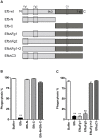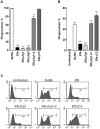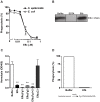Phagocytosis escape by a Staphylococcus aureus protein that connects complement and coagulation proteins at the bacterial surface
- PMID: 24348255
- PMCID: PMC3861539
- DOI: 10.1371/journal.ppat.1003816
Phagocytosis escape by a Staphylococcus aureus protein that connects complement and coagulation proteins at the bacterial surface
Abstract
Upon contact with human plasma, bacteria are rapidly recognized by the complement system that labels their surface for uptake and clearance by phagocytic cells. Staphylococcus aureus secretes the 16 kD Extracellular fibrinogen binding protein (Efb) that binds two different plasma proteins using separate domains: the Efb N-terminus binds to fibrinogen, while the C-terminus binds complement C3. In this study, we show that Efb blocks phagocytosis of S. aureus by human neutrophils. In vitro, we demonstrate that Efb blocks phagocytosis in plasma and in human whole blood. Using a mouse peritonitis model we show that Efb effectively blocks phagocytosis in vivo, either as a purified protein or when produced endogenously by S. aureus. Mutational analysis revealed that Efb requires both its fibrinogen and complement binding residues for phagocytic escape. Using confocal and transmission electron microscopy we show that Efb attracts fibrinogen to the surface of complement-labeled S. aureus generating a 'capsule'-like shield. This thick layer of fibrinogen shields both surface-bound C3b and antibodies from recognition by phagocytic receptors. This information is critical for future vaccination attempts, since opsonizing antibodies may not function in the presence of Efb. Altogether we discover that Efb from S. aureus uniquely escapes phagocytosis by forming a bridge between a complement and coagulation protein.
Conflict of interest statement
The authors have declared that no competing interests exist.
Figures








Similar articles
-
The Staphylococcus aureus polysaccharide capsule and Efb-dependent fibrinogen shield act in concert to protect against phagocytosis.Microbiology (Reading). 2016 Jul;162(7):1185-1194. doi: 10.1099/mic.0.000293. Epub 2016 Apr 25. Microbiology (Reading). 2016. PMID: 27112346 Free PMC article.
-
Staphylococcal protein Ecb impairs complement receptor-1 mediated recognition of opsonized bacteria.PLoS One. 2017 Mar 8;12(3):e0172675. doi: 10.1371/journal.pone.0172675. eCollection 2017. PLoS One. 2017. PMID: 28273167 Free PMC article.
-
Staphylococcus aureus proteins Sbi and Efb recruit human plasmin to degrade complement C3 and C3b.PLoS One. 2012;7(10):e47638. doi: 10.1371/journal.pone.0047638. Epub 2012 Oct 11. PLoS One. 2012. PMID: 23071827 Free PMC article.
-
Interactions between human plasma proteins and cell wall components of Staphylococcus aureus.Dan Med Bull. 1987 Apr;34(2):59-69. Dan Med Bull. 1987. PMID: 3556046 Review.
-
The staphylococcal surface-glycopolymer wall teichoic acid (WTA) is crucial for complement activation and immunological defense against Staphylococcus aureus infection.Immunobiology. 2016 Oct;221(10):1091-101. doi: 10.1016/j.imbio.2016.06.003. Epub 2016 Jun 15. Immunobiology. 2016. PMID: 27424796 Review.
Cited by
-
Immunization routes in cattle impact the levels and neutralizing capacity of antibodies induced against S. aureus immune evasion proteins.Vet Res. 2015 Sep 28;46:115. doi: 10.1186/s13567-015-0243-7. Vet Res. 2015. PMID: 26411347 Free PMC article.
-
Transcriptomic analysis of lipoteichoic acid‑treated undifferentiated and neutrophil‑like differentiated HL‑60 cells.Exp Ther Med. 2024 Feb 22;27(4):158. doi: 10.3892/etm.2024.12446. eCollection 2024 Apr. Exp Ther Med. 2024. PMID: 38476893 Free PMC article.
-
Neutrophils and Immunity: From Bactericidal Action to Being Conquered.J Immunol Res. 2017;2017:9671604. doi: 10.1155/2017/9671604. Epub 2017 Feb 19. J Immunol Res. 2017. PMID: 28299345 Free PMC article. Review.
-
Immunization of young heifers with staphylococcal immune evasion proteins before natural exposure to Staphylococcus aureus induces a humoral immune response in serum and milk.BMC Vet Res. 2019 Jan 7;15(1):15. doi: 10.1186/s12917-018-1765-9. BMC Vet Res. 2019. PMID: 30616609 Free PMC article.
-
More than a Pore: Nonlytic Antimicrobial Functions of Complement and Bacterial Strategies for Evasion.Microbiol Mol Biol Rev. 2021 Jan 27;85(1):e00177-20. doi: 10.1128/MMBR.00177-20. Print 2021 Feb 17. Microbiol Mol Biol Rev. 2021. PMID: 33504655 Free PMC article. Review.
References
-
- Nathan C (2006) Neutrophils and immunity: challenges and opportunities. Nat Rev Immunol 6: 173–182. - PubMed
-
- Gasque P (2004) Complement: a unique innate immune sensor for danger signals. Mol Immunol 41: 1089–1098. - PubMed
-
- Gros P, Milder FJ, Janssen BJC (2008) Complement driven by conformational changes. Nat Rev Immunol 8: 48–58. - PubMed
-
- Walport MJ (2001) Complement. First of two parts. N Engl J Med 344: 1058–1066. - PubMed
MeSH terms
Substances
Associated data
- Actions
Grants and funding
LinkOut - more resources
Full Text Sources
Other Literature Sources
Molecular Biology Databases
Miscellaneous

